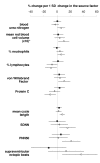Cardiovascular effects in patrol officers are associated with fine particulate matter from brake wear and engine emissions
- PMID: 15813985
- PMCID: PMC1074349
- DOI: 10.1186/1743-8977-1-2
Cardiovascular effects in patrol officers are associated with fine particulate matter from brake wear and engine emissions
Abstract
BACKGROUND: Exposure to fine particulate matter air pollutants (PM2.5) affects heart rate variability parameters, and levels of serum proteins associated with inflammation, hemostasis and thrombosis. This study investigated sources potentially responsible for cardiovascular and hematological effects in highway patrol troopers. RESULTS: Nine healthy young non-smoking male troopers working from 3 PM to midnight were studied on four consecutive days during their shift and the following night. Sources of in-vehicle PM2.5 were identified with variance-maximizing rotational principal factor analysis of PM2.5-components and associated pollutants. Two source models were calculated. Sources of in-vehicle PM2.5 identified were 1) crustal material, 2) wear of steel automotive components, 3) gasoline combustion, 4) speed-changing traffic with engine emissions and brake wear. In one model, sources 1 and 2 collapsed to a single source. Source factors scores were compared to cardiac and blood parameters measured ten and fifteen hours, respectively, after each shift. The "speed-change" factor was significantly associated with mean heart cycle length (MCL, +7% per standard deviation increase in the factor score), heart rate variability (+16%), supraventricular ectopic beats (+39%), % neutrophils (+7%), % lymphocytes (-10%), red blood cell volume MCV (+1%), von Willebrand Factor (+9%), blood urea nitrogen (+7%), and protein C (-11%). The "crustal" factor (but not the "collapsed" source) was associated with MCL (+3%) and serum uric acid concentrations (+5%). Controlling for potential confounders had little influence on the effect estimates. CONCLUSION: PM2.5 originating from speed-changing traffic modulates the autonomic control of the heart rhythm, increases the frequency of premature supraventricular beats and elicits pro-inflammatory and pro-thrombotic responses in healthy young men.
Figures



References
-
- WHO . The World health report: Reducing risks, promoting healthy life. Geneva, Switzerland, World Health Organisation; 2002.
-
- Peters A, Dockery DW, Muller JE, Mittleman MA. Increased particulate air pollution and the triggering of myocardial infarction. Circulation. 2001;103:2810–2815. - PubMed
LinkOut - more resources
Full Text Sources

